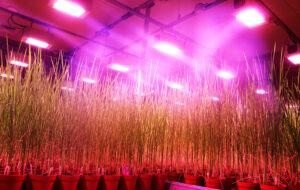by Mahender Anumalla, Margaret Catolos, Ma. Teresa Sta. Cruz, Joie Ramos, and Waseem Hussain
A milestone in rice breeding involved the SUB1 gene that enables rice to survive underwater for 14 days. This gene has been introduced into several mega rice varieties to overcome the challenges of flooding and provide relief to millions of poor rice farmers in flood-prone areas across the globe. One of these varieties, Swarna-Sub1, was hailed as a major innovation with great potential for helping rice farmers in flood-prone areas of India.
However, SUB1 rice varieties are not invincible when flooding extends beyond 14 days. The next goal is going and thinking beyond the SUB1 gene and hunting genotypes to develop the next-generation flood-tolerant varieties that can survive more than two weeks of submergence.

A milestone in rice breeding that made a big impact on a wide scale occurred in 1991. It involved a low-yielding traditional variety grown across limited areas in Orissa, India known as FR13A.
That year, Dr. David Mackill, a former plant breeder working at the International Rice Research Institute (IRRI) in the 1980s, and his graduate student Kenong Xu at the University of California at Davis, pinpointed the precise stretch of DNA that enabled FR13A to survive a week or more of complete submergence.
The assumed gene was named SUB1. The gene enables rice to survive underwater for 14 days. This gene has been introduced into several mega rice varieties to overcome the challenges of flooding and provide relief to millions of poor rice farmers in flood-prone areas across the globe. In 2015, one of these varieties, Swarna-Sub1, was hailed as a major innovation with great potential for helping rice farmers in flood-prone areas of India.
However, SUB1 rice varieties are not invincible when flooding extends beyond 14 days. On average, varieties with the gene have a meager survival rate of 10-30% under 21 days of submergence.
The next goal is going and thinking beyond the SUB1 gene and hunting genotypes that can survive more than two weeks of submergence. The development of the next-generation submergence/flood-tolerant genotypes is one of the goals of the breeding activities of the late-maturity breeding pipeline TLaSF-I at IRRI.
The critical question is whether we could move beyond SUB1?

The idea started in 2020. Key breeding tools like genomic selections, rapid generation advance, and population improvement (a breeding scheme to improve complex traits like yield through cyclic crossing and selection) were streamlined in the institute’s breeding programs for enhanced genetic gains under the umbrella of the OneRice breeding strategy.
The strategy creates a breeding framework that provides common terminology, resource management, size management, and allocation systems to further improve rice breeding efforts at IRRI, other CGIAR centers, and national agricultural research and extension systems (NARES) partners. The target is to develop and disseminate faster and more effective rice breeding across the system. The big challenge for us was implementing a population improvement breeding scheme for submergence breeding and aligning it with OneRice.
Earlier, the submergence breeding program aimed to develop high-yielding and submergence-tolerant genotypes by crossing high-yielding elite genotypes with submergence-tolerance donors. In this approach, submergence screening and yield selections were happening together, which is not ideal for driving a successful population improvement breeding scheme and enhancing genetic gains for yield.
How can we implement population improvement and genomic selections in TLaSF (submergence) breeding pipeline? How can we fix the submergence issue and strictly focus on yield and other market-preferable traits? How can we overcome the unpredictability and variability in the survival rate of the natural flooding fields?
We pondered these questions and developed a unique concept: Transition from Trait to Environment. This concept is similar to the Reductionist Approach commonly used in biology. It means simplifying and dividing complex things into individual components and studying them separately.
In our case, it is simplifying the breeding approach and separating submergence tolerance< from yield improvement. For example, we work on improving the submergence tolerance first, fixing it, and then moving to the yield improvement.
If we have 30 to 40 high-yielding genotypes, all submergence tolerant, we cross these 30-40 genotypes so any progeny that will come out of this will be tolerant to submergence. With this approach, we can focus on yield improvement to efficiently drive the population improvement breeding strategy and boost genetic gains.
However, identifying the elite genotypes and matching them to market preferences with complete submergence tolerance was daunting.

We started by screening more than 4,000 IRRI genotypes. Every year we narrowed it down to the high-yielding and submergence-tolerant genotypes. Finally, in 2023, we identified the best 40 elite genotypes having more than 80% survival under 21 days of submergence.
Our success is our unique approach and idea of thinking beyond 14 days of submergence. Our strength lies in our phenotypic screening capabilities, highly skilled team, and integration of modern quantitative genetics tools in breeding programs.
Our mission and vision are to create world-class germplasm for our NARES partners for flooding ecologies and set a global strategy for breeding and delivering better germplasm for flood-prone areas.







Good effort . We have to develop submergence Plus stagnant tolerant varitirs .Most of rainfed lowland area , submergence is combined by waterstagnent upto 40 to 50 days and farmers suffer due unstable and poor yield due this stress , especially in Easten India.